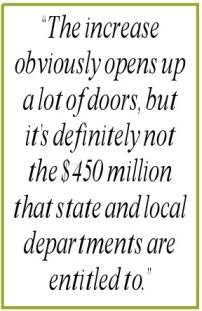A Coalition Throws its Support Behind the Land and Water Conservation Fund

With the amount of money and guarantees offered to various parks, recreation, conservation and wildlife programs by the Conservation and Reinvestment Act (CARA), it's not surprising that thousands of individuals and organizations in the recreation industry joined forces to back the bill in last year's 106th Congress.
The proposed CARA addressed several programs, including the Land and Water Conservation Fund (LWCF) and the Urban Parks and Recreation Recovery Program. Each program has a maximum dollar amount that Congress is authorized to appropriate to it each year. Since the programs are currently in the appropriations process, Congress every year gets to decide how much of the authorized amount to appropriate to each. Program officials never know how much money to expect from one year to the next.
CARA was designed to bring stability to this situation by promising the full authorized amount of funding to each program every year for 15 years. "The premise behind CARA was to fully fund the various conservation programs, take them out of the appropriations process and provide predictable funding - so it wasn't just to provide a lot of money, it was also to guarantee that the money would come every year," says Kelly Place, policy associate for the National Recreation and Park Association Policy Division.
The Conservation Fund was just one of the many programs addressed in CARA, but it was especially important to many of CARA's supporters. LWCF was established by Congress in 1964 to create parks and open spaces, protect wilderness and enhance recreational opportunities. Congress in 1968 made offshore oil and gas drilling lease proceeds a funding source for LWCF, and in 1977 increased the amount of funds available to $900 million per year, with $450 million distributed to federal lands and $450 million distributed to states in matching grants. Of course, LWCF is not necessarily funded at the available amount - as long as the fund is in the appropriations process, it is up to Congress each year to decide how much of that $900 million to appropriate to LWCF.
Supporters were feeling confident last year that they would get the full $900 million. After all, everything was going smoothly for CARA up until the very last days of the 106th Congress. The House overwhelmingly passed CARA last May, 315102. The Senate Energy and Natural Resources Committee then passed its own version of CARA, and 66 senators signed a letter approving the passage of CARA in the full Senate - but the bill never reached the Senate floor.
Opposing arguments on issues such as property rights and environmental concerns cropped up and stalled CARA. Many opponents of the bill expressed displeasure with the federal side of LWCF, because the federal money is used specifically for land acquisition - their concern being that the federal government already owns too much land, especially in the Western states. Another issue that was raised, this time by environmentalists, was that the funding for LWCF comes from oil and gas receipts, and that CARA would act as an incentive for more drilling, thus making additional money for LWCF. "That's not the case at all," says Place. "LWCF is already set up with certain leases, so any additional money that comes from oil and gas drilling wouldn't go into that fund."
Nevertheless, the concerns were enough to prevent CARA from passing. Congress instead issued a compromise version of CARA that was passed last October as part of the fiscal 2001 spending bill for the Department of the Interior. The compromise - the Land Conservation, Preservation and Infrastructure Improvement Program (LCPIP) - was embedded in the interior appropriations bill and significantly gutted CARA in terms of funds and future fund guarantees. Instead of $45 billion in funding guaranteed over the next 15 years for conservation, preservation and public land acquisition, the LCPIP provides $12 billion for the next six years, but the funds are not guaranteed and must go through the appropriations process each year. Congress appropriated $1.6 billion for fiscal 2001, and the funding is supposed to increase each year for six years until it reaches a total of $2.4 billion in 2006. LCPIP includes funding for LWCF's federal and state programs, urban parks under the Urban Park and Recreation Recovery Program, conservation easements, wildlife and endangered species protection, historic preservation and coastal protection programs.
While CARA would have fully funded LWCF at $900 million, the compromised version funded LWCF at $536 million, with $445.5 million appropriated for the federal program and $90.5 million for the matching state grants. That $90.5 million is distributed among the 50 states, whereupon the individual states take half of the money and give the other half in grants to local parks and recreation departments and conservation programs.
Although supporters believe that LCPIP was an improvement, others feel that it fell short in state and local funding. "The compromise was a step forward," says Myrna Johnson, vice president of government affairs at the Outdoor Recreation Coalition of America and chairperson of Americans for Our Heritage and Recreation (AHR). "On the other hand, I think the state and local programs did not do nearly as well as the federal programs, and that's one of the AHR's concerns. Let's make good on the state and local level. That's where the need is the greatest."
It is important to note that state LWCF funding in fiscal 2001 was a vast improvement from previous years. State departments received $24.8 million in FY 1993 and in FY 1994, but nothing at all from FY 1995 through FY 1999. In FY 2000, the states received $40 million. "The funds did increase for 2001," Place concedes. "The increase obviously opens up a lot of doors for applications and funding sources, but it's definitely not the $450 million that state and local departments are entitled to."
Some LWCF state liaison officers agree, saying that the current funds don't even come close to meeting all the needs within their respective states. "As we've kept track in recent years, it's been about three-to-one oversubscribed," says Craig Karr, LWCF liaison officer and director of the Division of Customer Service and External Relations of the Wisconsin Department of Natural Resources. "For every dollar we're able to give out in a grant, there were three times that many dollars requested." Wisconsin received $1,638,948 from LWCF for FY 2001.
Andrew Sansom, LWCF liaison officer and executive director of the Texas Parks and Wildlife Department, tells a similar story. In FY 2001, Texas received $4,632,920 in LWCF funds. "We have a local government grant program here, as well," Sansom says. "We normally distribute in a year about $16 million to local departments, and we have requests for somewhere between $30 and $35 million every year. So, we manage to address about half the needs that are expressed to us."
Examples of local park and recreation department projects in Texas using LWCF funds include an El Paso river park located along the Rio Grande and a 22-mile-long park with hiking trails in the Houston area. LWCF funds are not just for conservation or nature projects, however. Says Sansom, "It would be fair to say that most of our local grants projects involve outdoor athletic complexes of some fashion."
In fact, LWCF money can be used for a wide range of projects, including land acquisition for parks and other purposes - to construct or repair recreation and park facilities, including baseball and softball diamonds, to provide riding and hiking trails, to enhance recreation access and to conserve wildlife habitats for wildlife protection and management.
Although many projects qualify for LWCF grants, a large number of them are turned away due to a lack of funds. For this reason, each state department must prioritize the project requests according to its own specific criteria. Karr says there is a "fantastic number" of applicants in Wisconsin that meet all the state's criteria, but still receive no LWCF funds because there is not enough money to go around.
If CARA had passed in the 106th Congress, Wisconsin would have received about $8 million, with about $4 million passed on to local departments - an incredible prospect compared to the approximately $800,000 the state's local communities received this fiscal year.
Supporters of CARA are trying their best to put a good spin on the LCPIP. "It's fewer years, fewer dollars, fewer guarantees," Johnson says, "but we looked at it as a partial victory."
Full victory, supporters believe, is still in sight as the 107th Congress begins budget deliberations for FY 2002. President Bush on numerous occasions has recommended full funding of LWCF for FY 2002. However, it was unclear at press time how this would square with Bush's projected $1.6 trillion tax cut over the next 10 years.
LWCF continues to reap support in Congress. The House of Representatives in February reintroduced CARA, which is almost identical to last year's bill except that a few of the smaller programs are no longer included. The Senate had not yet introduced its version of the bill at press time.
Johnson says that the AHR's main goal is full funding for LWCF, so AHR members plan to use a two-track strategy in this congressional go-round. They will first work to make sure the money promised in LCPIP comes through, and they will also support efforts to pass CARA. "There will be some challenges," Johnson admits. "The compromise dollars are out there, and it could be very difficult for people to support this bigger initiative when there was a compromise last year. That's why we're working both arenas. Let's force them to make good on the promises they made last year, and if they don't, then we will go back to them with a permanent, guaranteed funding alternative."
Meanwhile, other federal, state and local parks, recreation and natural resources professionals have mobilized for the 107th Congress, hoping to achieve the full funding for LWCF they feel they deserve. "There were years in the past when LWCF was a much higher priority, and the funding was welcomed," says Karr. "It will be welcomed again, there's no question. It'll allow things to be done that just can't be done now because there isn't enough money."
































